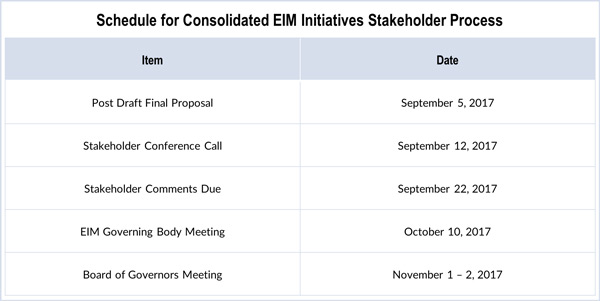By Jason Fordney
CAISO is dropping a handful of proposed enhancements to the Western Energy Imbalance Market (EIM) less than two months before the ISO’s Board of Governors is slated to review a broader package that still contains other changes.
The ISO decided to abandon three portions of its Consolidated EIM Proposal initiative based on stakeholder feedback.
One proposal would have allowed non-EIM third-party transmission owners to provide transfer capacity in the market, another adjusted management of bilateral schedule changes, and a third was to ensure payments to EIM entities that currently don’t get compensation for wheeling power.
The purpose of the effort was to combine EIM initiatives from the 2017 roadmap into one package in order to gain stakeholder input.
“Based on stakeholder feedback from the issue paper and straw proposal, the ISO decided to remove the 2017 roadmap items from [the] scope of the initiative,” CAISO said in its Sept. 5 draft final proposal.
CAISO kicked off the EIM proposal process in June. (See Consolidated EIM Proposal Effort Gets Underway.) The broader package is due to be reviewed by the EIM Governing Body on Oct. 10 prior to a Nov. 1 vote by the board.
Third-party TOs had expressed interest in providing transfer capacity in the EIM, but that proposal fizzled. Some of those outside owners have since received approval to enter the EIM, and there was a lack of interest among stakeholders in the measure. (See CAISO Drops EIM Third-Party Transmission Plan.)
CAISO Market Design and Policy Specialist Don Tretheway told RTO Insider on Thursday that the third-party TO proposal will still be included in the ISO’s annual policy initiatives catalog. It might be a solution to concerns regarding net wheeling, and EIM transfer costs could be used to enable compensation for a transmission contribution, he said during a Tuesday presentation.
The ISO said it felt it was unnecessary to pursue changes to management of bilateral schedules. Some market participants want the base schedule deadline moved up 10 minutes. Under current practice, changes made after submitting base schedules are exposed to real-time imbalance settlement payments. The ISO provided examples of how EIM entities can manage bilateral schedule changes through their tariffs and business practices.
Also dropped was the proposal to compensate EIM participants for wheeling power through their balancing authorities into neighboring areas. All EIM entities currently show more net transfers in and out their territories than wheel-through transactions, so they are benefiting more than they are facilitating wheels, CAISO said. But the ISO will monitor and post net wheeling data and include it in the quarterly benefits report. That initiative will also remain in the catalog to be possibly addressed later.
Although CAISO dropped the enhancements, it is moving forward with new EIM functionalities to be implemented in the winter of 2017. They include automated matching of import and export schedule changes with a single EIM nonparticipating resource; automated mirroring of system resources at ISO intertie scheduling points; base EIM transfer system resource imbalance settlement; non-generator resource modeling functionality; and allowing submission of base generation distribution factors for aggregated EIM non-participating resources.





